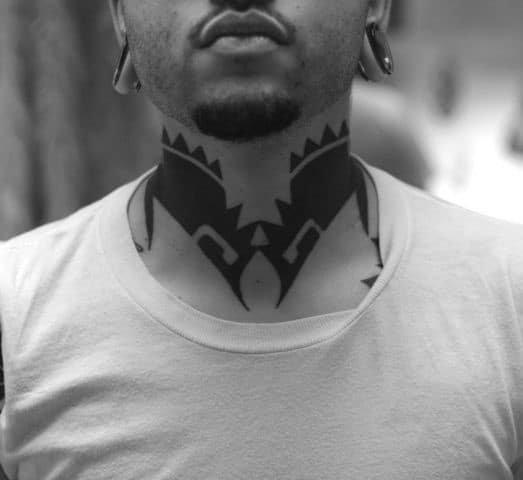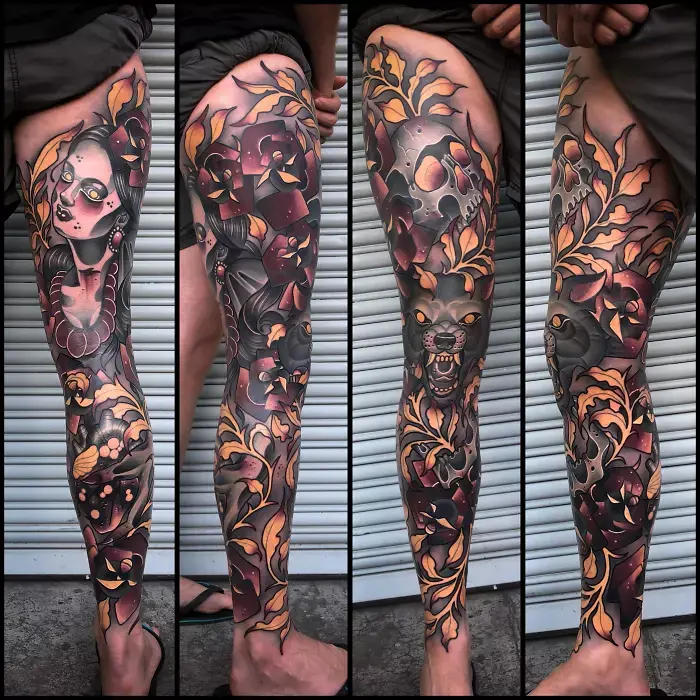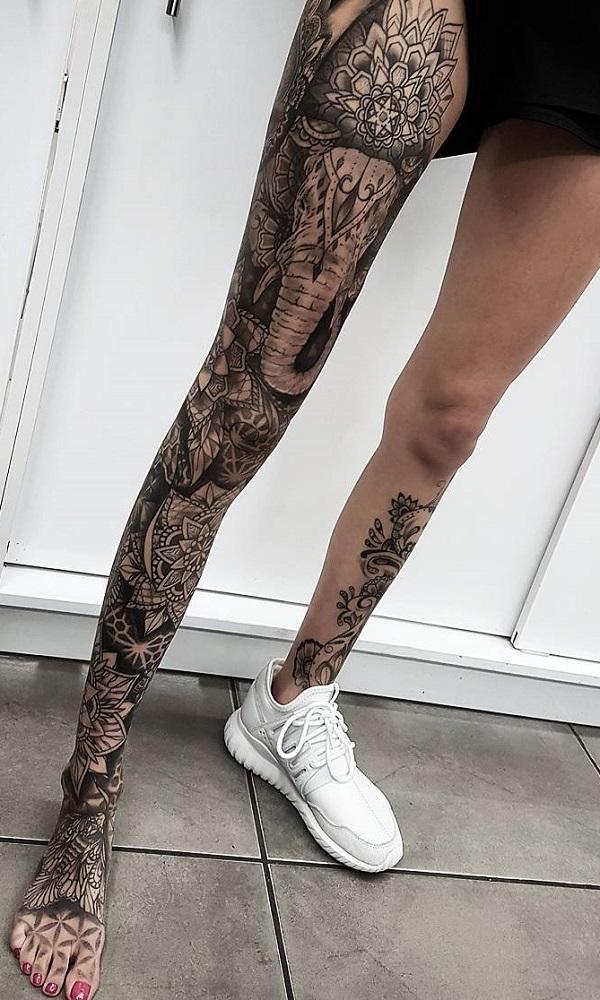Tattooing has become an increasingly popular form of self-expression, with people choosing to adorn their bodies with unique and meaningful designs. One popular area for tattoos is the legs, offering a vast canvas to showcase intricate artwork. This article will delve into the world of leg tattoos, exploring various design options, their meanings, and the considerations to keep in mind when planning your leg tattoo.
The Allure of Leg Tattoos

Leg tattoos have gained immense popularity due to their versatility and the ability to showcase large, detailed designs. Unlike tattoos on other parts of the body, leg tattoos provide a larger surface area, allowing artists to create intricate and visually stunning pieces. Moreover, the legs offer a unique opportunity to display tattoos that can be easily hidden when desired, making them a popular choice for those who want the option of discretion.
Design Considerations for Leg Tattoos
When planning a leg tattoo, there are several factors to consider. The first is the placement. The leg offers multiple areas to consider, from the upper thigh to the calf, each with its own unique characteristics. The size and shape of the tattoo will also play a significant role in determining the placement. For instance, a large, intricate piece may be best suited for the outer thigh, where there is ample space to showcase the design.
Another important consideration is the skin tone and texture. The legs, especially the calves and ankles, can have varying skin tones and textures due to factors like sun exposure and natural pigmentation. It's crucial to choose a design that complements the natural characteristics of your skin to ensure the tattoo looks its best.
Additionally, the flexibility and movement of the legs must be taken into account. The legs are constantly in motion, and certain designs may be better suited to handle the stretching and bending that occurs with everyday activities. Tattoos with fine lines and delicate details may require more careful placement to avoid distortion over time.
| Leg Area | Skin Characteristics | Design Suitability |
|---|---|---|
| Upper Thigh | Generally smooth and even skin tone | Large, detailed pieces; abstract art |
| Outer Thigh | May have more variation in skin tone and texture | Bold, colorful designs; floral motifs |
| Calf | Can be more muscular with varying skin tones | Geometric patterns; animal designs |
| Ankle | Often has delicate skin with fine veins | Small, delicate designs; single-color tattoos |

Exploring Popular Leg Tattoo Designs

Leg tattoos offer a wide range of design possibilities, catering to various tastes and preferences. Here are some popular design choices and their meanings:
Floral and Nature-Inspired Tattoos
Floral motifs are a timeless choice for leg tattoos. Whether it’s a delicate rose, a vibrant peony, or a wildflower meadow, floral tattoos can symbolize love, beauty, and new beginnings. These designs often incorporate vibrant colors and intricate details, making them a stunning choice for leg tattoos.
Additionally, nature-inspired tattoos, such as trees, mountains, or celestial bodies, can convey a sense of connection to the natural world. These designs often hold deep personal meanings and can be a beautiful way to express one's love for the environment.
Abstract and Geometric Tattoos
For those seeking a more modern and artistic approach, abstract and geometric tattoos offer a unique visual appeal. These designs often feature bold lines, shapes, and patterns, creating a visually striking effect. Abstract tattoos can represent freedom, individuality, and a departure from traditional tattoo styles.
Geometric tattoos, on the other hand, focus on precise shapes and symmetry. They can incorporate elements like triangles, circles, and mandalas, often holding symbolic meanings related to balance, harmony, and spiritual growth.
Animal and Creature Tattoos
Leg tattoos provide an excellent canvas for animal and creature designs. From majestic birds of prey to graceful sea creatures, these tattoos can symbolize strength, freedom, and the beauty of the natural world. Each animal holds its own unique symbolism, allowing for a highly personalized tattoo.
For example, a wolf tattoo can represent loyalty and family, while a dragon tattoo may symbolize power and protection. These tattoos often feature vibrant colors and intricate details, making them a popular choice for leg tattoos.
Personalized and Symbolic Tattoos
Leg tattoos also offer an opportunity to express personal stories and memories. Many individuals opt for tattoos that hold deep personal meanings, such as family crests, significant dates, or symbols representing important life events. These tattoos are often unique and highly personalized, making them a meaningful addition to one’s body art collection.
Additionally, leg tattoos can be used to showcase favorite quotes, lyrics, or meaningful phrases. These tattoos serve as a daily reminder of one's values and aspirations, providing a constant source of inspiration.
Leg Tattoo Aftercare and Maintenance
Proper aftercare is crucial to ensure the longevity and vibrancy of your leg tattoo. Here are some essential tips to keep in mind:
- Keep the tattooed area clean and dry for the first 24 hours.
- Apply a thin layer of tattoo ointment or moisturizer to the tattooed skin as recommended by your artist.
- Avoid direct sunlight and tanning beds for at least 4-6 weeks after getting the tattoo.
- Wear loose-fitting clothing to avoid irritation and allow the tattoo to breathe.
- If swimming or bathing, ensure the tattooed area is fully healed before immersion.
Regular maintenance is also important to keep your leg tattoo looking its best. This includes regular exfoliation to remove dead skin cells and moisturization to prevent dryness and fading. Consulting with a professional tattoo artist or dermatologist can provide further guidance on maintaining your tattoo's appearance.
Conclusion
Leg tattoos offer a captivating way to express oneself through body art. With a vast array of design options, from floral motifs to abstract art, there is a leg tattoo to suit every taste and preference. By considering factors like placement, skin characteristics, and personal symbolism, individuals can create leg tattoos that are not only visually stunning but also deeply meaningful.
Whether you're considering a leg tattoo or already have one, understanding the design possibilities and aftercare requirements can ensure a positive and rewarding experience. Remember, tattoos are a form of self-expression, and with the right approach, they can become a beautiful and permanent part of your personal story.
How much does a leg tattoo typically cost?
+The cost of a leg tattoo can vary widely depending on several factors, including the size and complexity of the design, the artist’s skill and experience, and the location of the tattoo shop. On average, leg tattoos can range from a few hundred dollars for a small, simple design to several thousand dollars for larger, more intricate pieces. It’s best to consult with a few reputable tattoo artists in your area to get accurate quotes for your specific design idea.
Are leg tattoos painful? How can I manage the pain?
+The pain associated with leg tattoos can vary from person to person. Some areas of the leg, like the upper thigh, are generally considered less sensitive, while areas like the ankle or calf may be more sensitive. To manage the pain, it’s recommended to stay hydrated, eat a healthy meal before your appointment, and discuss pain management strategies with your tattoo artist. They may recommend techniques like deep breathing or taking short breaks during the tattooing process.
How long does it take to heal a leg tattoo?
+The healing time for a leg tattoo can vary depending on the size and location of the tattoo, as well as individual healing factors. On average, it can take around 2-3 weeks for the initial healing process, during which time the tattoo may appear slightly raised and itchy. It’s important to follow proper aftercare instructions provided by your tattoo artist to ensure a smooth healing process and minimize the risk of infection or scarring.